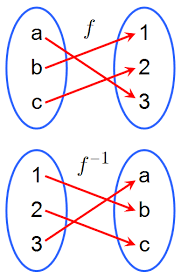Functions Explained

a. Injective and Surjective Functions:
Injective Functions (One-to-One Functions): An injective function is a type of function in which each element of the domain is mapped to a unique element in the codomain. In other words, for every two distinct elements "a" and "b" in the domain, the function values f(a) and f(b) will also be distinct. This means that no two different elements in the domain can be mapped to the same element in the codomain. Injective functions are often referred to as "one-to-one" functions.
Surjective Functions (Onto Functions): A surjective function is a type of function in which every element in the codomain has at least one corresponding element in the domain that maps to it. In simpler terms, the function "covers" the entire codomain, meaning there are no elements in the codomain that are left unmapped. In other words, for every element "b" in the codomain, there exists an element "a" in the domain such that f(a) = b.
b. The Pigeonhole Principle:
The Pigeonhole Principle is a combinatorial principle that states that if you have "n" pigeonholes and more than "n" pigeons to put into these pigeonholes, then at least one of the pigeonholes must contain more than one pigeon. In the context of functions, it is used to illustrate the concept of injective and surjective functions. If a function maps elements from a larger set (pigeons) to a smaller set (pigeonholes), then it is impossible for the function to be injective because there will be more pigeons (elements) than pigeonholes (distinct function values). Conversely, if a function maps elements from a smaller set to a larger set, then it is impossible for the function to be surjective because some pigeonholes (elements in the codomain) will be left empty.
c. Compositions:
Function composition is a way of combining two or more functions to create a new function. Given two functions, f: A → B and g: B → C, the composition function g∘f, read as "g after f" or "g composed with f," is a function that maps elements from set A to set C. The composition function is defined as (g∘f)(x) = g(f(x)), where the output of the function f is used as the input for the function g. Function composition allows us to model complex processes by breaking them down into smaller, manageable steps using individual functions.
d. Inverse Functions:
The inverse function of a function f: A → B is a function that undoes the action of f. If a function f has an inverse, it is denoted as f-1. For a function f-1 to be the inverse of f, it must satisfy two conditions:
1. (f-1 ∘ f)(x) = x for every x in the domain of f, meaning applying f-1 after f should yield the original input value.
2. (f ∘ f-1(x)) = x for every x in the domain of f-1, meaning applying f after f-1 should also yield the original input value.
Inverse functions are unique for injective (one-to-one) functions because they reverse the mapping of the original function.
e. Image and Preimage:
*Image: The image of a function is the set of all possible function values obtained when elements from the domain are mapped through the function. It is denoted as "Im(f)" and is a subset of the codomain. In set notation, Im(f) = {f(x) | x ∈ Domain of f}.
Preimage: The preimage of an element "b" in the codomain is the set of all elements in the domain that map to "b" under the function. In set notation, the preimage of "b" under the function f is denoted as f-1 {b} and is defined as {x | f(x) = b}. Note that this notation refers to the preimage of a specific element "b," not the inverse function. The preimage may be empty if there is no element in the domain that maps to "b" under the function.